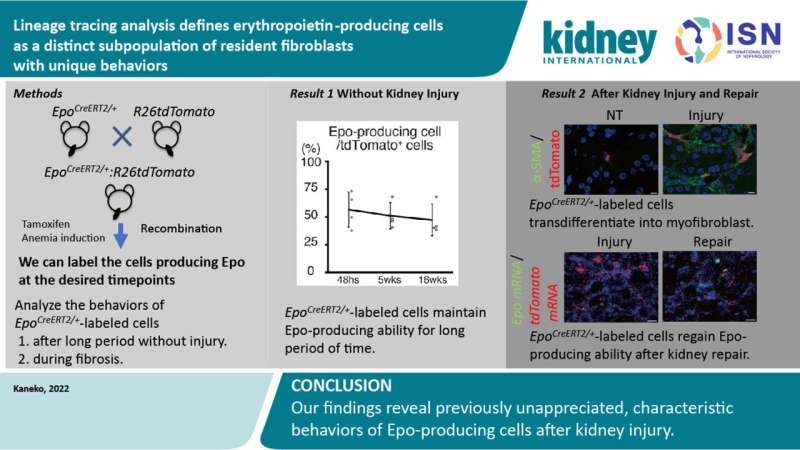Researchers describe characteristic behaviors of erythropoietin-producing kidney cells

A research team at Kyoto University has revealed characteristic behaviors of erythropoietin (Epo)-producing cells. Epo is a hormone produced by the kidney that stimulates red blood cell production. The discovery provides further insight into the mechanism of renal anemia, a common complication of chronic kidney disease—low red blood cell count—which is caused by renal insufficient production of Epo.
"Patients with chronic kidney disease have impaired Epo production, resulting in renal anemia. Renal anemia can lead to a variety of harmful effects," explains group leader Motoko Yanagita of the university's Institute Advanced Study of Human Biology (ASHBi). "We know that Epo is produced by some fibroblasts in the kidney but we don't know if all fibroblasts have the innate ability to produce Epo."
Fibroblasts in the kidney are a group of cells that help to support the overall structure of the organ and maintain organ homeostasis, but questions remain regarding which of these cells can make Epo and what happens to them after they are damaged.
Building on their previous work, the team led by researchers from ASHBi genetically engineered a strain of mice which label Epo-producing cell at desired time points. This allowed them to follow the pattern of Epo production before and after kidney damage and confirm that only a special group of fibroblasts can make the hormone without kidney injury.
After confirming that only a specialized group of fibroblasts produce the hormone under physiological conditions, the team induced a kind of artificial kidney damage and watched as the Epo-producing cells changed into another kind of cell called myofibroblasts. These cells helped to contain the damage to the kidney but also lost the ability to produce Epo.
However, watching the cells after kidney repair, the team found that rather than other fibroblasts taking over Epo-making duties, the original Epo-making cells recovered their ability.
Yanagita says, "The Epo-producing cells are clearly unique among all resident fibroblasts. We expect this insight to be useful for elucidating the mechanism of renal anemia and developing novel treatment methods that might help to recover Epo-producing cells in patients living with chronic kidney disease."
The paper, "Lineage tracing analysis defines erythropoietin-producing cells as a distinct subpopulation of resident fibroblasts with unique behaviors," was published on 26 May 2022 in Kidney International.
More information: Keiichi Kaneko et al, Lineage tracing analysis defines erythropoietin-producing cells as a distinct subpopulation of resident fibroblasts with unique behaviors, Kidney International (2022). DOI: 10.1016/j.kint.2022.04.026




















